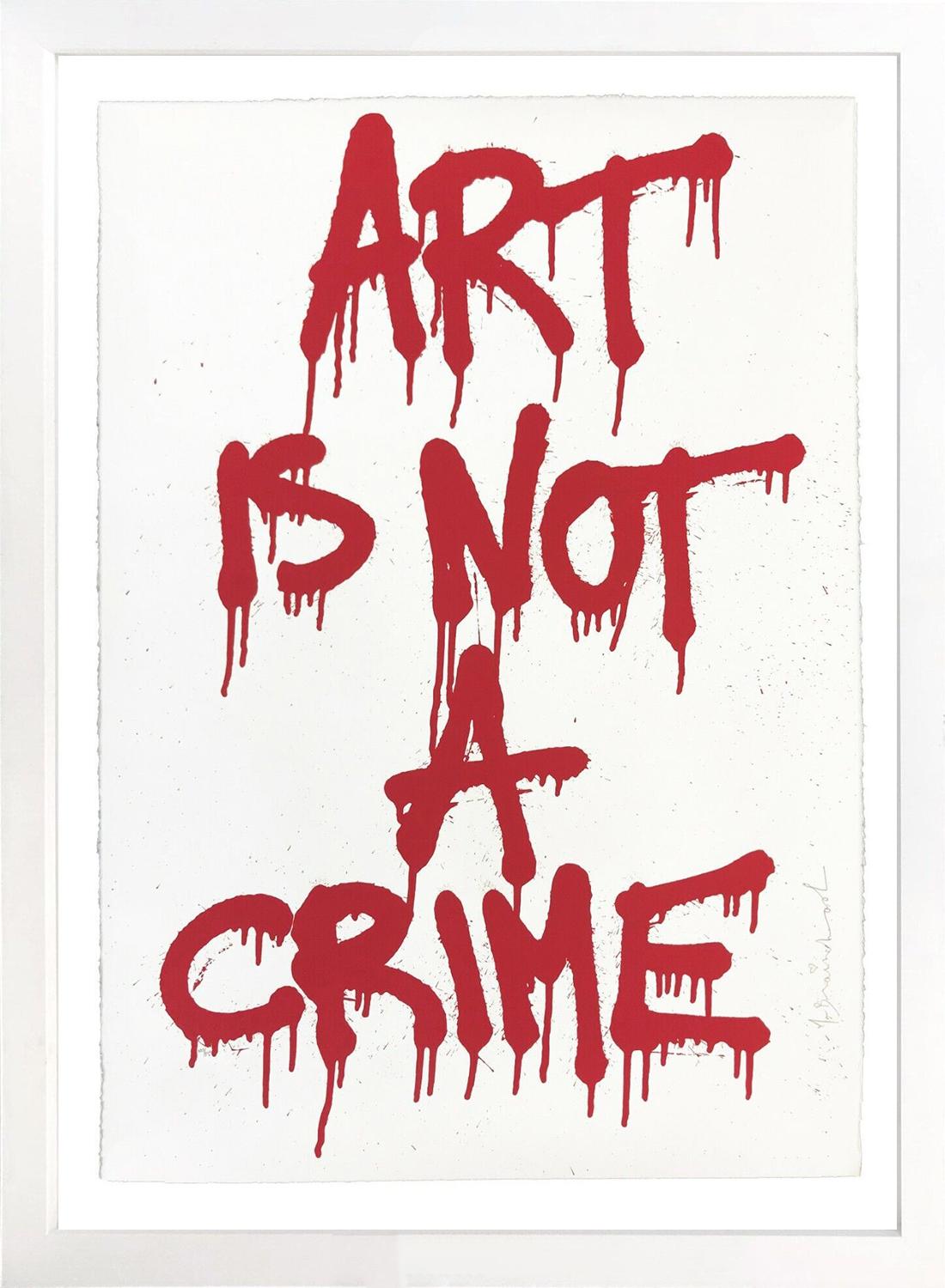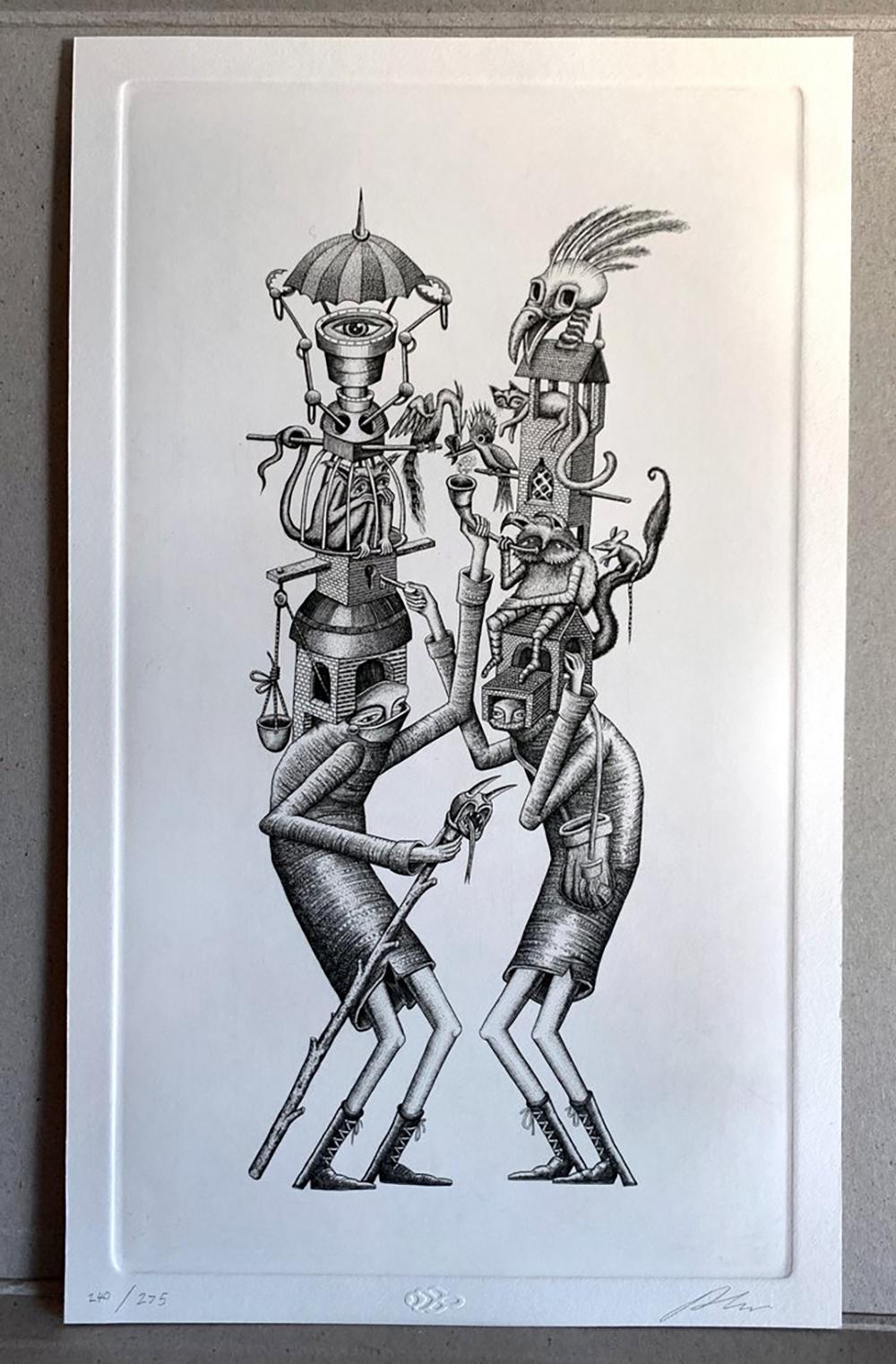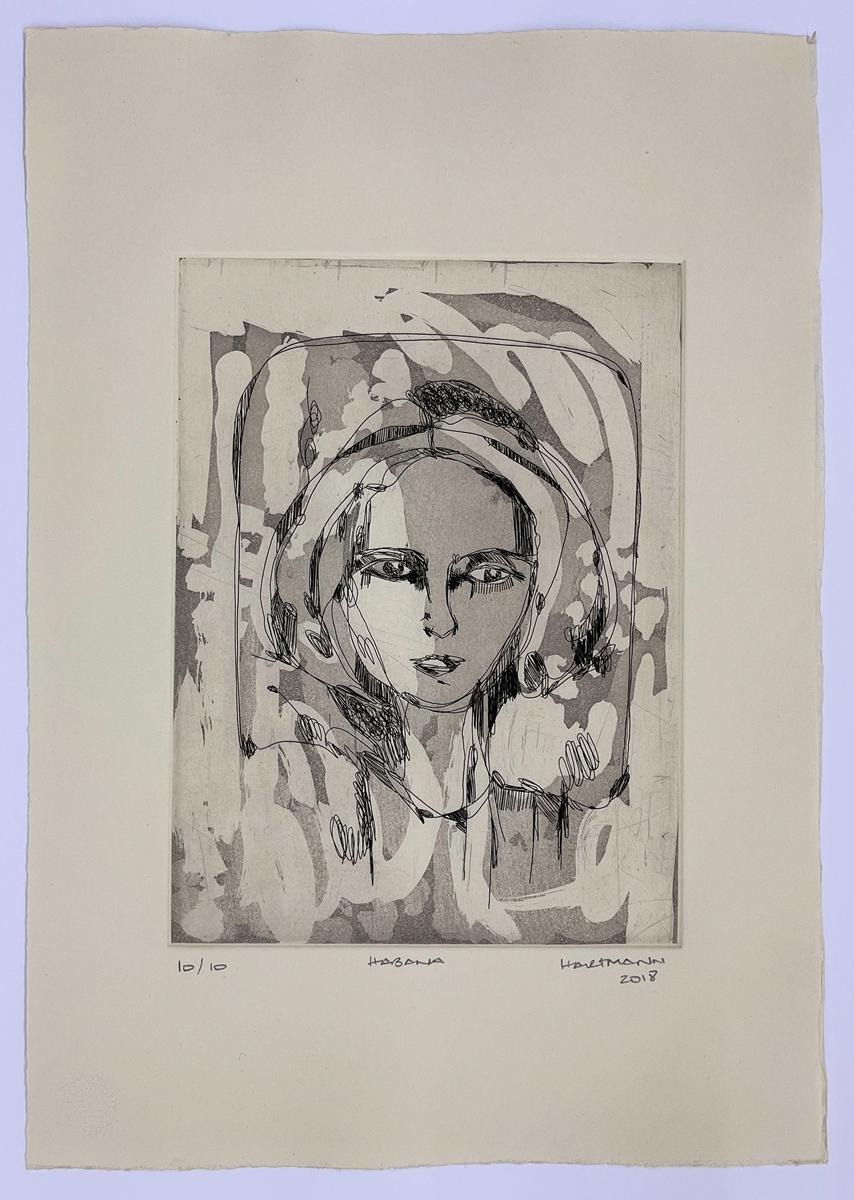Items Similar to Becoming the Clown
Want more images or videos?
Request additional images or videos from the seller
1 of 5
Hector RuizBecoming the Clown2006
2006
About the Item
Copper etching with aquatint
The power of memory and how it recalls individuality begins in such basic experiences as the ability to link internal ideas to external manifestations of those ideas. Memories as simple as an old toy or a street can set off a chain reaction of thoughts that snowball into issues as broad as nationalism, identity politics or a body politic to name a few. Hector Ruiz’s works encompass the broad, complex and often painful world particular to the Arizona and neighboring Mexican landscape. United States and Mexican border issues, immigration conflicts of gender and sexuality and urban development oblivious to the needs of the individual and the landscape create a combinative world that is seen through Ruiz’s own emotionally critical lens instead of through a universal one.
Having grown up in the border states of Texas and Arizona and spending many summers visiting family in Piedras Negras, Mexico, Ruiz consciously chooses to reside in Arizona because it is the most conservative of the border states. He prefers the conservatism because it is matched only by a rigorous activism that attempts to protect Mexican immigrants. Interminable debates of nation and rights are central to the life o any Arizonan. The fluidity of culture and peoples that are an effect of the border reinforce ongoing tensions such as nationalism versus cosmopolitanism, fragmentation versus unity, group mentalities versus individual ones and host of others.
Uncanny in its historical reflection, the same set of clashed existed in pre- and postwar Germany at the turn of the 20th century. A country faltering within its own fluid borders, its people felt their national, thus personal, identity slipping away in the face of internationalism, urbanism and industry. The vitality inherent to polarization, however, gave birth to the German Expressionist movement that became such a crucial facet of 20th century Modernism. Although late 19th and early 20th century Germany’s search for one nation/one identity is notably less complex than the United States’ Mexican border issues of today; there is a comparable rift in identity experienced by both Mexicans and Americans in addition to the difficulties that originate from the continuous social readjusting necessitated by globalization.
Lightly referencing many of the various schools and artists from the 30-some year period of German Expressionism, Ruiz draws a singular inspiration from the artist max Bachmann. Beckmann, the German Expressionist who defies many of his contemporaries with an insistent individuality, develops his own language through paintings and prints using tense, conflicted compositions, broad, black lines, and densely inhabited surfaces that bow with tension of their relationship to the two-dimensional background.
More contemporary artists who emerge in Beckmann’s wake also create fertile ground for Ruiz. In the late 1960’s and 1970’s, Phillip Guston’s strong, choppy lines and use of black as a color (in sushc a way that it is an unmistakable nod to Beckmann) makes way for his subject matter fo bodies, body parts and heads. In the 1980’s Jean-Michel Basquiat also make reference to both Beckmann and Guston, with his abundant use of bodies, body parts, animals, archetypal symbols, figures and densely packed surfaces.
Undoubtedly these influences transform into a hybrid mixture when seen in conjunction with 19th century Mexican political cartoonist Jose Guadelupe Posada’s works. Posada’s cartoons are ubiquitous stylistically and are still used in modes of Mexican popular art today. The cartoonish, raw, woodblock print style of skeletons lampooning reporters and political figures parallel the vision of the aforementioned artists who drive toward the truth at breakneck speed. Like his forebears, Ruiz uses truth as a weapon or tool employing the “ancient, traditional and deep-rooted foundations” of his Mexican, Native American and American background to wrench back the veil of over-development, the sterilizing effects of globalization and the havoc wreaked by border conflicts.
After graduating with a Bachelor of Fine Arts degree from Arizona State University in 1994, Ruiz quickly sought out alternative forms of art making and thought. He traveled extensively in India and asia, where he co-opted ancient spiritual texts such as the Bhagavad-Gita and forms of Buddhist thought to help lay the groundwork for ideas that have fueled his current work.
Woodcarvings and linoprints are his chosen mediums. Benefiting from the advantages of being self-taught in these skills, Ruiz’s woodcutting abilities concisely express his artistic intent. He is able to create and resource personal, visual statements and language through themes and repetitive images as well as make strong reference to craft in a way that transforms the strictures of ”folk” art into a forceful regional language.
- Creator:Hector Ruiz (American)
- Creation Year:2006
- Dimensions:Height: 18 in (45.72 cm)Width: 14.5 in (36.83 cm)
- More Editions & Sizes:1 x 10Price: $1,100
- Medium:
- Movement & Style:
- Period:
- Condition:
- Gallery Location:Phoenix, AZ
- Reference Number:
About the Seller
5.0
Gold Seller
These expertly vetted sellers are highly rated and consistently exceed customer expectations.
Established in 1984
1stDibs seller since 2012
61 sales on 1stDibs
- ShippingRetrieving quote...Ships From: Phoenix, AZ
- Return PolicyA return for this item may be initiated within 3 days of delivery.
More From This SellerView All
- Daybed DaydreamBy Hector RuizLocated in Phoenix, AZcopper etching with aquatint The power of memory and how it recalls individuality begins in such basic experiences as the ability to link internal ideas to external manifestations of those ideas. Memories as simple as an old toy or a street can set off a chain reaction of thoughts that snowball into issues as broad as nationalism, identity politics or a body politic to name a few. Hector Ruiz’s works encompass the broad, complex and often painful world particular to the Arizona and neighboring Mexican landscape. United States and Mexican border...Category
Early 2000s Outsider Art Figurative Prints
MaterialsCopper
- Untitled Etching / Suite of 4By Martin MullLocated in Phoenix, AZetching; unframed available editions: 1, 2 and 3 of 20Category
1990s Abstract Prints and Multiples
MaterialsArchival Paper, Etching
- WOP 2-00600By Hiro YokoseLocated in Phoenix, AZmixed media on paper Image size: 15 x 12.5 inches Neoromantic painter Hiro Yokose fuses multiple layers of wax and oil paint to create mysterious, veiled landscapes illuminated wit...Category
Early 2000s Minimalist Abstract Drawings and Watercolors
MaterialsMixed Media, Archival Paper
- WOP 2-00602 (H)By Hiro YokoseLocated in Phoenix, AZmixed media on paper Image size: 12.75 x 24 inches Neoromantic painter Hiro Yokose fuses multiple layers of wax and oil paint to create mysterious, veiled landscapes illuminated wi...Category
Early 2000s Abstract Abstract Drawings and Watercolors
MaterialsMixed Media, Archival Paper
- Fractal Dance IXBy Mark PomilioLocated in Phoenix, AZcharcoal on paper Mark Pomilio’s method, motives, and conceptual considerations are centered on visually articulating recent developments in the life sciences. It is not his intent ...Category
2010s Abstract Geometric Drawings and Watercolor Paintings
MaterialsCharcoal, Archival Paper
- Fractal Dance VIIIBy Mark PomilioLocated in Phoenix, AZcharcoal on paper Mark Pomilio’s method, motives, and conceptual considerations are centered on visually articulating recent developments in the life sciences. It is not his intent ...Category
2010s Abstract Geometric Abstract Drawings and Watercolors
MaterialsCharcoal, Archival Paper
You May Also Like
- ART IS NOT A CRIMEBy Mr. BrainwashLocated in Aventura, FLColor screen print on hand-torn archival art paper. Hand signed and numbered, with a thumb print on the back. From the edition of 300. Frame size approx 33 x 25 inches. Artwork is...Category
2010s Street Art Figurative Prints
MaterialsScreen, Archival Paper
- Phlegm - Customary Hats - Urban Graffiti Street ArtLocated in Asheville, NCCustomary Hats: Artists: Phlegm Year: 2020 Class: Art Print Released: 12/09/20 Run: 275 Technique: Etching Paper: Fabriano Rosaspina 280gsm Size: 7.874 X 12.992 Markings: ...Category
2010s Street Art Figurative Prints
MaterialsBlack and White, Engraving, Etching, Screen
- FADING GLOW (RED GOLD LEAF)By SnikLocated in Aventura, FLColor screen print on 300 GSM somerset paper. Hand signed and numbered on front by Snik. From the edition of 15. Frame size approx 29 x 29 inches. Artwork is in excellent conditi...Category
2010s Street Art Figurative Prints
MaterialsGold Leaf
- Cleopatra. Notes from the Underground. 1978, paper, aquatint, 22x25cmLocated in Riga, LVEpr. d'Art. Cleopatra. Notes from the Underground. 1978, paper, aquatint, 22x25 cm Lev Kropivnitsky / Лев Евгеньевич Кропивницкий (1922-1994) Russian nonconformist artists, poet,...Category
1970s Conceptual Figurative Prints
MaterialsPaper, Aquatint
- "That One Time I Modeled Lingerie" Printmaking: Photogravure, Aquatint EtchingLocated in New York, NY"That One Time I Modeled Lingerie" Printmaking: Photogravure and Aquatint Etching on Paper, Framed Dimensions: 13 x 16in, Framed 22 x 24 x 1in This piece is a Limited Edition of 25, ...Category
2010s Contemporary Figurative Prints
MaterialsEtching, Aquatint, Photogravure, Paper
- Roxana Hartmann, ¨Habana¨, 2018, Etching, 15.9x11.2 inLocated in Miami, FLRoxana Hartmann (Bolivia, ) 'Habana', 2018 etching, sugar aquatint on paper Feltmark 300 g 16 x 11.3 in. (40.5 x 28.5 cm.) Edition of 10 ID: HAR-101-008 UnframedCategory
2010s Contemporary Portrait Prints
MaterialsPaper, Etching, Aquatint
Recently Viewed
View AllMore Ways To Browse
Mexico Border
American Sterilizer
Romano Venezia
Salvador Dali The Hippies
Viktor Giclee
Dorian Gray Book
Dubonnet Poster
Jacques Soisson
Lucky Strike Cigarettes Vintage
Paul Brien
Peter Max Composition Red And Green
Peter Max God Bless America
Pisces Horoscope
Pkz Posters
Raphael Soyer Self Portrait Signed
Richard Davies On Sale
Sam Park On Sale
The Men Who Eat Each Other




